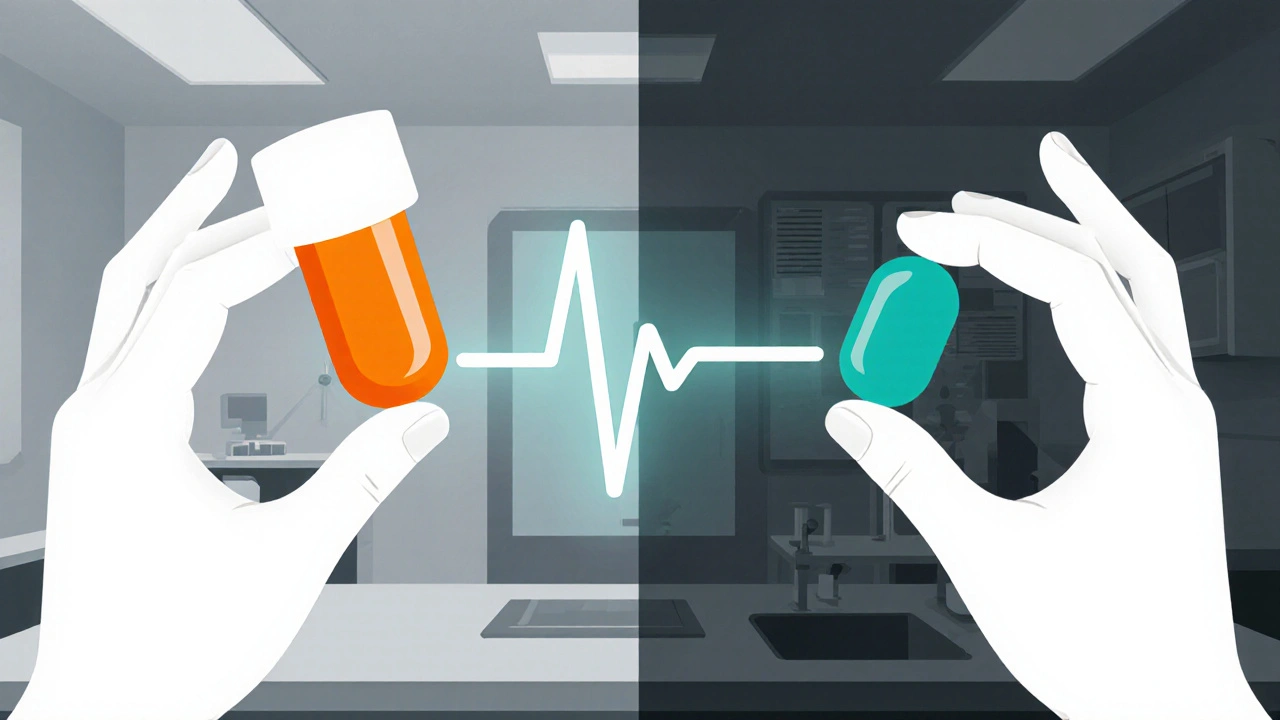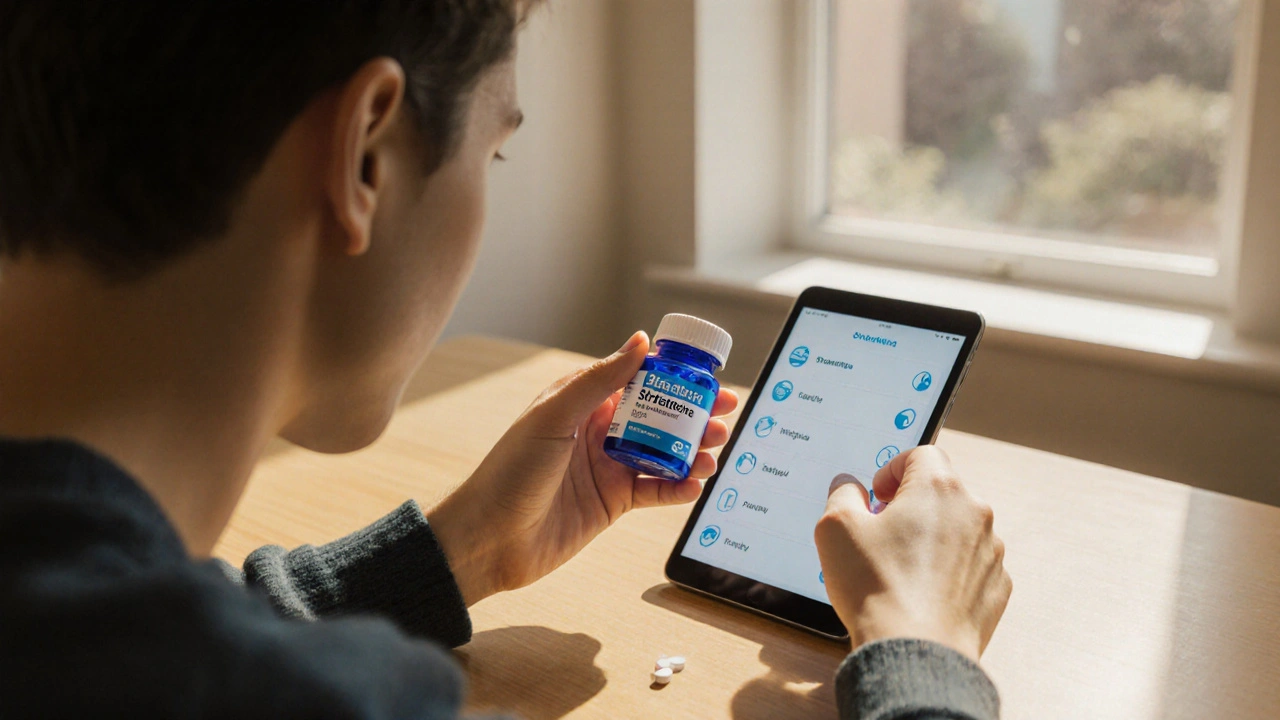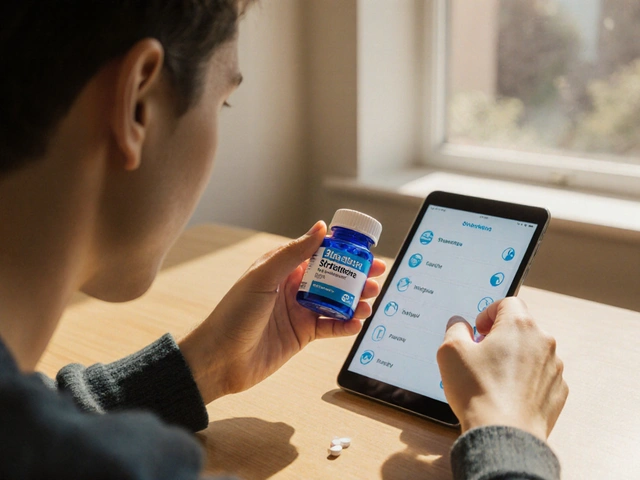ADHD Medication Matchmaker
Choose your priorities to find the most suitable ADHD medication for your situation. Answer a few simple questions about your health needs and lifestyle.
Key Takeaways
- Strattera (atomoxetine) works differently from stimulants, so it’s a good option for patients with substance‑abuse concerns.
- Stimulant alternatives such as Adderall, Ritalin, Vyvanse, and Concerta generally act faster but carry higher abuse potential.
- Intuniv and bupropion are non‑stimulant choices that target specific comorbidities like tics or depression.
- Cost varies widely; generic atomoxetine and methylphenidate are usually cheapest, while lisdexamfetamine and brand‑only guanfacine can be pricey.
- Choosing the right drug means balancing efficacy, side‑effect profile, lifestyle needs, and insurance coverage.
When you or a loved one is diagnosed with ADHD, the first question isn’t "which pill should I take?" but "what drug fits my life best?" Strattera often shows up in the conversation because it’s the only non‑stimulant FDA‑approved for ADHD in both children and adults. But it isn’t the only game‑changer. Below is a deep‑dive comparison that lets you weigh atomoxetine against the most common alternatives, understand where each shines, and decide what makes sense for your health context.
What Is Strattera (Atomoxetine)?
Strattera is the brand name for atomoxetine, a selective norepinephrine reuptake inhibitor (NRI) approved by the FDA for treating attention‑deficit/hyperactivity disorder (ADHD). Unlike stimulant medications, which boost dopamine and norepinephrine by blocking reuptake, atomoxetine specifically blocks norepinephrine reuptake, leading to a slower, steadier increase in neurotransmitter levels.
Typical dosing starts at 40mg once daily for children 6years and older, with a target range of 0.5mg/kg up to a maximum of 100mg per day. Adults usually begin at 40mg and may titrate to 80mg or 100mg based on response and tolerability. Because it isn’t a controlled substance, atomoxetine carries no schedule rating, which eases prescribing restrictions.
How Strattera Differs From Stimulants
Stimulants such as Adderall (mixed amphetamine salts) and methylphenidate‑based drugs act within 30‑60minutes, delivering a noticeable boost in focus that can last 4‑12hours depending on formulation. Atomoxetine, by contrast, may take 2‑4weeks to reach full effect because it works through gradual neurochemical adjustments.
Key distinctions:
- Abuse potential: Stimulants are Schedule II substances with a high risk of misuse; atomoxetine is unscheduled.
- Cardiovascular impact: Both classes can raise blood pressure, but stimulants often cause a sharper increase in heart rate.
- Comorbid conditions: Atomoxetine may be preferable for patients who also have anxiety, tics, or a family history of substance‑use disorder.

Major Alternatives to Strattera
Below are the most widely prescribed ADHD drugs that patients typically consider alongside atomoxetine. Each entry includes the drug’s class, typical dosage range, onset of action, duration, FDA‑approved age group, common side effects, and an approximate annual cost in the United States (2025 data).
- Adderall - mixed amphetamine salts (stimulant). Immediate‑release (IR) dose 5‑30mg 2-3×/day; extended‑release (XR) 10‑30mg once daily. Onset: 30‑60min; Duration: 4‑6hrs (IR) / 10‑12hrs (XR). FDA‑approved for ages 3‑50. Common side effects: insomnia, appetite loss, increased blood pressure. Approx. annual cost: $1,200 (brand) or $300 (generic).
- Ritalin - methylphenidate (stimulant). IR 5‑20mg 2-3×/day; XR (Ritalin LA) 10‑30mg once daily. Onset: 20‑45min; Duration: 3‑4hrs (IR) / 8‑10hrs (LA). FDA‑approved ages 6‑17 (IR) and 6‑55 (LA). Common side effects: stomach ache, headache, mood swings. Approx. annual cost: $900 (brand) or $250 (generic).
- Vyvanse - lisdexamfetamine dimesylate (stimulant pro‑drug). Dose 30‑70mg once daily. Onset: 1‑2hrs; Duration: 10‑14hrs. FDA‑approved ages 6‑17 (pediatric) and adults. Common side effects: dry mouth, anxiety, weight loss. Approx. annual cost: $1,800 (brand).
- Concerta - extended‑release methylphenidate. Dose 18‑72mg once daily. Onset: 1‑2hrs; Duration: 10‑12hrs. FDA‑approved ages 6‑17 (pediatric) and adults. Common side effects: insomnia, irritability, abdominal pain. Approx. annual cost: $1,500 (brand) or $350 (generic).
- Intuniv - guanfacine extended‑release (non‑stimulant). Dose 1‑4mg once daily, usually in the evening. Onset: 1‑2weeks; Duration: 24hrs. FDA‑approved ages 6‑17 (pediatric). Common side effects: drowsiness, low blood pressure, fatigue. Approx. annual cost: $1,100 (brand).
- Bupropion - norepinephrine‑dopamine reuptake inhibitor (off‑label for ADHD). Dose 150‑450mg daily divided into 1‑2 doses. Onset: 2‑3weeks; Duration: 24hrs. FDA‑approved for depression and smoking cessation, but often prescribed off‑label for ADHD in adults. Common side effects: insomnia, dry mouth, seizures at high doses. Approx. annual cost: $200 (generic).
Side‑by‑Side Comparison Table
| Drug | Class | Onset | Duration | Abuse Potential | Common Side Effects | Approx. Annual Cost (USD) |
|---|---|---|---|---|---|---|
| Strattera (Atomoxetine) | Selective NRI (non‑stimulant) | 2‑4weeks | 24hrs (once‑daily) | None (unscheduled) | Dry mouth, nausea, decreased appetite, mood swings | $650 (generic) |
| Adderall (XR) | Mixed amphetamine (stimulant) | 30‑60min | 10‑12hrs | High (Schedule II) | Insomnia, increased BP, appetite loss | $300 (generic) |
| Ritalin (LA) | Methylphenidate (stimulant) | 20‑45min | 8‑10hrs | High (Schedule II) | Stomach ache, headache, mood swings | $250 (generic) |
| Vyvanse | Lisdexamfetamine (stimulant pro‑drug) | 1‑2hrs | 10‑14hrs | High (Schedule II) | Dry mouth, anxiety, weight loss | $1,800 (brand) |
| Concerta | Methylphenidate (stimulant) | 1‑2hrs | 10‑12hrs | High (Schedule II) | Insomnia, irritability, abdominal pain | $350 (generic) |
| Intuniv | Guanfacine extended‑release (non‑stimulant) | 1‑2weeks | 24hrs | None (unscheduled) | Drowsiness, low BP, fatigue | $1,100 (brand) |
| Bupropion | NDRI (off‑label) | 2‑3weeks | 24hrs | Low (unscheduled) | Insomnia, dry mouth, seizure risk at high dose | $200 (generic) |
Decision‑Making Criteria
Picking the right ADHD drug isn’t just about “which works best” - it’s about how each fits into a person’s health profile and daily routine. Use the checklist below to rank the criteria that matter most to you.
- Efficacy for core symptoms: Measured by improvement in attention, impulsivity, and hyperactivity scores. Stimulants typically yield a 30‑40% symptom reduction; atomoxetine averages 20‑30% but may improve comorbid anxiety.
- Onset of action: If you need quick symptom control (e.g., before school or a presentation), a stimulant’s rapid onset is valuable.
- Side‑effect tolerance: Consider appetite suppression, sleep disruption, cardiovascular effects, or mood changes. Non‑stimulants often have milder daytime side effects but may cause fatigue.
- Substance‑use risk: A personal or family history of misuse pushes the choice toward atomoxetine, guanfacine, or bupropion.
- Comorbid conditions: Anxiety, tic disorders, or depression may be better addressed with non‑stimulant options.
- Cost & insurance coverage: Generic stimulants are cheap; brand‑only options like Vyvanse can be expensive without a formulary tier.
- Convenience: Once‑daily dosing (e.g., Strattera, Vyvanse, Concerta) simplifies adherence compared to multiple‑dose regimens.
Best‑Fit Scenarios
Below are quick “who should consider what” snapshots. They’re not strict rules, but they help you map personal factors to drug profiles.
- Strattera (Atomoxetine): Ideal for adults with a history of substance‑use disorder, patients who experience severe anxiety with stimulants, or those who need a once‑daily non‑controlled medication.
- Adderall XR: Good for students or professionals needing strong, fast‑acting focus during the day and who have no cardiovascular concerns.
- Ritalin LA: Works well for children who need coverage across school hours but may be sensitive to the “spike‑crash” pattern of IR forms.
- Vyvanse: Best for patients who want a smoother rise and longer coverage, especially if they’ve struggled with the abrupt peaks of other stimulants.
- Concerta: Suitable for adolescents needing steady coverage without multiple dosing, particularly if they respond well to methylphenidate.
- Intuniv (Guanfacine): Preferred when tics, aggression, or high blood pressure are concerns; often used as an adjunct to a low‑dose stimulant.
- Bupropion: Considered for adults with co‑existing depression or smoking cessation goals, provided seizure risk is low.
Switching or Combining Therapies
Many patients don’t land on the perfect drug the first time. Here are proven steps to transition safely:
- Consult your prescriber and get baseline vitals (BP, HR) and a symptom rating scale.
- If moving from a stimulant to atomoxetine, taper the stimulant over 1‑2 weeks to avoid rebound ADHD symptoms.
- Start atomoxetine at the low end of the dose range; monitor for liver function (rare) and mood changes during the first month.
- When adding a non‑stimulant like Intuniv to a stimulant, start the non‑stimulant at the lowest dose and watch for excessive sedation.
- Schedule follow‑up visits at 2‑week intervals initially, then every 3‑4 months once stable.
Remember, medication is only one piece of the ADHD management puzzle. Behavioral therapy, exercise, and sleep hygiene dramatically boost any drug’s effectiveness.
Frequently Asked Questions
Can I take Strattera and a stimulant at the same time?
Yes, doctors sometimes prescribe a low‑dose stimulant alongside atomoxetine to cover the initial weeks when Strattera’s effect is still building. This combo is called “augmentation” and should be closely monitored for blood pressure changes.
Is atomoxetine safe for children?
The FDA approved Strattera for children 6years and older. Clinical trials showed it improves attention without the jitteriness some stimulants cause, but parents should watch for rare liver issues and mood swings.
How long does it take to see results with Strattera?
Most patients notice a modest improvement after 2‑4weeks, with the full therapeutic effect often reached by 6‑8weeks.
What are the main side effects that differ from stimulants?
Atomoxetine more commonly causes dry mouth, mild nausea, and sometimes sleep disturbance, whereas stimulants tend to cause appetite loss, insomnia, and increased heart rate.
Is Strattera covered by most insurance plans?
Because it’s generic, many plans list atomoxetine on their preferred drug list, resulting in co‑payments of $10‑$30. However, brand‑only formulations may be higher, so check your formulary.
Next Steps & Troubleshooting
After you’ve reviewed the table and matched your health profile to a drug, follow this quick plan:
- Make a list of your top three criteria (e.g., low abuse risk, fast onset, budget).
- Consult your prescriber with that list; ask specific questions about each drug’s fit.
- Start a trial of the chosen medication at the lowest recommended dose. Track symptoms daily in a simple notebook or app.
- If side effects appear, note severity and timing. Bring this data to your next appointment - dosage tweaks often solve issues.
- Re‑evaluate after 6‑8weeks. If you haven’t hit a 20% symptom reduction, discuss switching or augmenting as outlined earlier.
Remember, the right ADHD medication is a personal match, not a one‑size‑fits‑all. Use the data here as your compass, not the final word, and keep the conversation open with your healthcare team.



Comments
When you’re juggling ADHD meds, think of it like assembling a band-each instrument has its own timbre, and the right mix delivers the harmony you need.
Stimulants bring the electrifying guitar riffs that scream focus in minutes, while non‑stimulants like Strattera provide the steady bass line that underpins the whole set without the risk of feedback.
Cost, insurance, and personal health quirks are the road‑crew that can make or break the tour.
If you’ve got a history of substance use, the unscheduled nature of atomoxetine can keep the stage safe.
On the other hand, students racing for paper deadlines often crave that instant amp‑up a stimulant offers.
Bottom line: map your priorities, then let your prescriber fine‑tune the dosage.
For anyone worrying about the price tag, generic versions of atomoxetine and methylphenidate typically sit under $300 a year, which makes them accessible for most insurance plans.
Meanwhile, brand‑only options like Vyvanse can climb well above $1,500, so it’s worth checking if a formulary alternative exists before signing a big prescription.
💡 A quick mental shortcut: if you need a medication that lasts the whole workday without a mid‑afternoon crash, look for extended‑release formulations like Concerta or Vyvanse; they’re engineered to release the drug gradually, smoothing out peaks and valleys.
🔄 If you’re already on a stimulant and still feel jittery, adding a low‑dose non‑stimulant such as guanfacine can temper the upswing without sacrificing focus.
Remember to schedule a baseline blood pressure check before starting any stimulant; the rise is usually modest, but it can tip over the edge for those with hypertension.
Indeed,-as the economic ramifications of psychiatric pharmacotherapy burgeon-one must, without doubt, scrutinize the formularies' tiered structures, lest the unwary patient be ensnared by fiscal labyrinths, and thereby, inadvertently, compromise therapeutic adherence; a judiciously selected generic, therefore, serves not merely as a cost‑saving measure, but as a cornerstone of sustained clinical efficacy.
Consider, for a moment, the neurochemical symphony that atomoxetine conducts: by lingering on norepinephrine reuptake, it orchestrates a calm crescendo, allowing the mind to focus without the frantic surge that stimulants impose.
This subtlety can be a lifeline for those whose anxiety flares at the mere whisper of adrenaline, offering a path to clarity that feels less like a thunderstorm and more like a gentle rain.
Embarking on the journey to find the perfect ADHD medication is far more than a simple checklist; it is a nuanced expedition through the intertwined landscapes of neurobiology, lifestyle, and personal values.
First, acknowledge that the brain’s dopamine and norepinephrine systems are the primary conductors of attention, and each class of drugs pulls a different lever on these messengers.
Stimulants, such as Adderall and Ritalin, act swiftly, flooding synapses with dopamine, which can translate to an almost instantaneous sharpening of focus, yet this rapidity also carries a heightened risk of tolerance and misuse.
In contrast, atomoxetine-commercially known as Strattera-takes a slower, more deliberate route by selectively inhibiting norepinephrine reuptake, requiring weeks to manifest its full therapeutic potential, but offering a safety profile that is unburdened by Schedule II restrictions.
Second, weigh the side‑effect spectrum: stimulants often usher in appetite suppression, insomnia, and a palpable increase in heart rate, while non‑stimulants may introduce dry mouth, mild nausea, or subtle mood fluctuations.
Third, factor in comorbidities; individuals wrestling with anxiety or tic disorders frequently find relief with non‑stimulants, as the latter avoid the jittery amplification that stimulants can exacerbate.
Financial considerations also loom large: generic methylphenidate and atomoxetine can be sourced for a few hundred dollars annually, whereas brand‑only options like Vyvanse may exceed the thousand‑dollar threshold, a disparity that can dictate adherence.
Insurance formularies often prefer generics, so a conversation with your pharmacist can unveil preferred alternatives and potential prior‑authorization pathways.
Fourth, contemplate dosing convenience-a once‑daily regimen minimizes the ritualistic burden and reduces the likelihood of missed doses, benefits that are especially salient for students and professionals with packed schedules.
Never underestimate the power of adjunctive strategies; behavioral therapy, regular exercise, and disciplined sleep hygiene can amplify medication benefits and sometimes allow for lower dosages.
Be vigilant about cardiovascular health; baseline blood pressure and heart rate measurements are prudent before initiating stimulants, with periodic monitoring thereafter.
Maintain an open dialogue with your prescriber; dose titration is often an iterative process, and reporting side effects promptly can prevent unnecessary discontinuations.
Switching medications is a common part of the therapeutic arc; a gradual taper of a stimulant, followed by a low‑dose introduction of atomoxetine, can smooth the transition and mitigate rebound symptoms.
If you experience persistent mood swings or emergent suicidal thoughts on atomoxetine, immediate clinical evaluation is warranted, as rare but serious psychiatric side effects have been documented.
Remember that the ultimate goal is functional improvement-whether that translates to better academic performance, more consistent work output, or enhanced relationships, the metric should always be your lived experience, not merely symptom scores.
Finally, embrace the process as a partnership with your healthcare team, armed with data, patience, and a willingness to adjust, and you will likely arrive at a regimen that feels tailored, sustainable, and empowering.
The odyssey you described, steeped in scientific rigor yet painted with poetic flair, truly captures the labyrinthine nature of ADHD pharmacotherapy.
One extra layer to consider is the emerging evidence that combining a low‑dose stimulant with atomoxetine can create a synergistic effect, shaving off the latency period while preserving the low‑abuse advantage of the non‑stimulant.
This hybrid approach, though still off‑label, has shown promise in adult populations who struggle with both executive dysfunction and comorbid anxiety.
👍 Got it, keep an eye on the side‑effects.
Monitoring blood pressure and sleep patterns can help distinguish whether a side‑effect is medication‑related or lifestyle‑driven.
If you’re battling a high‑risk environment for substance misuse, the unscheduled status of Strattera makes it a viable frontline option, especially when paired with robust counseling support.
Exactly! 😊 A solid therapeutic alliance plus a non‑controlled med can really tip the scales toward recovery.
While many focus on the immediate cognitive boost, long‑term neuroplastic changes induced by consistent medication adherence often underpin sustained functional gains.
It is, indeed, an axiomatic truth within contemporary neuropsychiatric discourse that the durability of therapeutic outcomes is inextricably linked to the constancy of pharmacological modulation, thereby rendering intermittent dosing regimens suboptimal from a neurodevelopmental perspective.
Let’s take that insight and turn it into action: set a simple reminder, track your daily dose in a journal, and schedule a follow‑up in six weeks to evaluate progress and fine‑tune the plan.